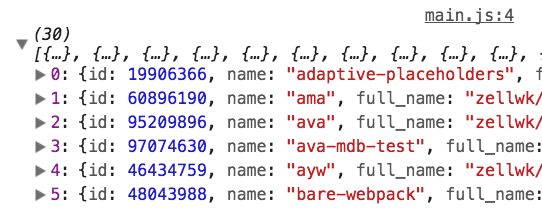The Fetch API
Hey ,
I'm thrilled to help you learn JavaScript. Unfortunately, you've landed on a page where you cannot access with your current purchase.
Please upgrade (use this link) access this content.
I'm super eager to help you learn more!
Hey ,
I'm thrilled to help you learn JavaScript. Unfortunately, you've landed on a page where you cannot access with your current purchase.
Please upgrade (use this link) access this content.
I'm super eager to help you learn more!
The Fetch API (Fetch from now on) is a newer method that lets you perform Ajax. It is a better alternative compared to XHR. It can be used in newer technologies, like Service Workers, where XHR is discouraged.
(We won’t be covering Service Workers in this course).
To send a request with Fetch, you use the fetch method.
fetch(url, options)
url is the address you want to request information from.
options is a JavaScript object that lets you provide extra options. We’ll examine the options in a later lesson.
Here’s the fetch request to get a list of my Github repositories.
fetch('https://api.github.com/users/zellwk/repos')
Note: Fetch sends out your request immediately when you write fetch. This is unlike XHR, where you send the request with send method.
To see the response from Fetch, you need to write a then statement.
fetch('https://api.github.com/users/zellwk/repos')
.then(response => console.log(response))

The response looks different from an XHR’s response. The data we want is hidden in the body property as a readable stream.
We need to convert this readable stream into JavaScript before we can use it. To do so, we use the json method that comes with a Fetch response.
You will be able to see the data you requested with a second then call.
fetch('https://api.github.com/users/zellwk/repos')
.then(response => response.json())
.then(data => console.log(data))

The rest is similar—you need to massage the data before you can use it.
fetch('https://api.github.com/users/zellwk/repos')
.then(response => response.json())
.then(data => {
// Massage data and output to DOM here
})
Fetch is based on promises. If we want to understand fetch and the whole then thing, we need to know what promises are and how they work.
Do this:
fetch('https://api.github.com/users/zellwk/repos')
.then(r => r.json())
.then(repos => {
const htmlString = repos.map(repo => {
return {
name: repo.name,
url: repo['html_url'],
stars: repo['stargazers_count']
}
})
.filter(repo => repo.stars > 50)
.map(repo => `<li>${repo.name}: ${repo.stars} stars</li>`)
.join('')
const ol = document.createElement('ol')
ol.innerHTML = htmlString
document.body.appendChild(ol)
})